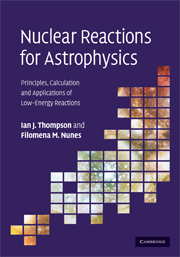Book contents
- Frontmatter
- Contents
- Preface
- Sources of quotations
- Acknowledgements
- 1 Nuclei in the Cosmos
- 2 Reactions of nuclei
- 3 Scattering theory
- 4 Reaction mechanisms
- 5 Connecting structure with reactions
- 6 Solving the equations
- 7 Approximate solutions
- 8 Breakup
- 9 Three-body nuclei
- 10 R-matrix phenomenology
- 11 Compound-nucleus averaging
- 12 Stellar reaction rates and networks
- 13 Connection to experiments
- 14 Spectroscopy
- 15 Fitting data
- Appendix A Symbols
- Appendix B Getting started with Fresco
- Select bibliography
- Index
14 - Spectroscopy
Published online by Cambridge University Press: 05 March 2012
- Frontmatter
- Contents
- Preface
- Sources of quotations
- Acknowledgements
- 1 Nuclei in the Cosmos
- 2 Reactions of nuclei
- 3 Scattering theory
- 4 Reaction mechanisms
- 5 Connecting structure with reactions
- 6 Solving the equations
- 7 Approximate solutions
- 8 Breakup
- 9 Three-body nuclei
- 10 R-matrix phenomenology
- 11 Compound-nucleus averaging
- 12 Stellar reaction rates and networks
- 13 Connection to experiments
- 14 Spectroscopy
- 15 Fitting data
- Appendix A Symbols
- Appendix B Getting started with Fresco
- Select bibliography
- Index
Summary
There are two possible outcomes: if the result confirms the hypothesis, then you've made a measurement. If the result is contrary to the hypothesis, then you've made a discovery.
Enrico FermiIn order to learn about the internal properties of nuclei, some kind of reaction is necessary. The most interesting questions concern the arrangements of nucleons inside the nucleus, and, for this purpose, transfer reactions have been the standard procedure for examining the single-particle structure of nuclei and extracting spectroscopic factors. Transfer experiments in the sixties and seventies were abundant, but they suffered a decrease of popularity following the shutdown of some low-energy laboratories. They are now becoming popular again to study exotic nuclei, as more intense beams are produced in ISOL facilities. In this chapter we primarily discuss the various features of transfer reactions.We present the standard theory used to analyze these reactions, namely the DWBA, look at its advantages and limitations, and then consider other approaches that handle higher-order effects. We compare transfer probes with electron knockout and nuclear knockout reactions. At the end of the chapter we briefly discuss chargeexchange reactions, which are used to extract Fermi or Gamow-Teller transition strengths.
Transfer spectroscopy
We begin by discussing standard DWBA theory for describing transfer reactions. This theory is most useful for reactions that probe the surface regions of the nuclei, and try to measure the spectroscopic factors of the single-particle states.
- Type
- Chapter
- Information
- Nuclear Reactions for AstrophysicsPrinciples, Calculation and Applications of Low-Energy Reactions, pp. 379 - 402Publisher: Cambridge University PressPrint publication year: 2009



